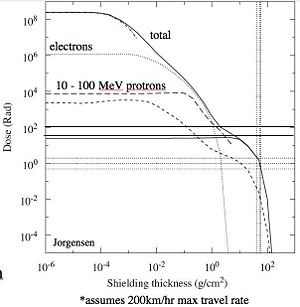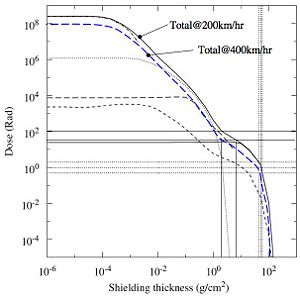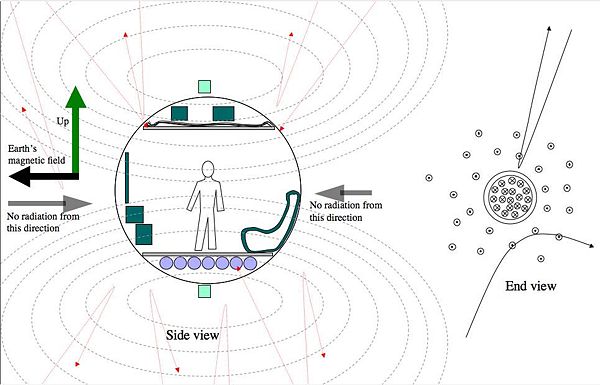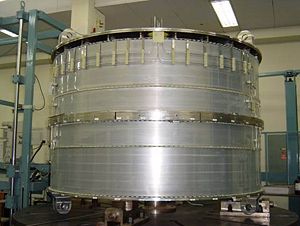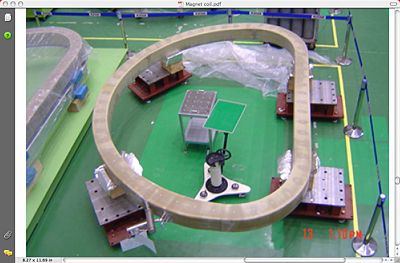RadProtection: Difference between revisions
No edit summary |
|||
| (10 intermediate revisions by 4 users not shown) | |||
| Line 1: | Line 1: | ||
== Radiation Protection for Humans in Transit == | == Radiation Protection for Humans in Transit == | ||
The best initial work in this area was done by Anders Jorgensen (Anders Jorgensen et. al., Acta Astronautica 60 (2007) 198 – 209). Anders evaluated the environment and presented the raw case for people in the Earth's radiation belts. | |||
A re-evaluation with a focus on how to make manned transport up the space elevator was conducted by Brad Edwards and presented at the Luxembourg Space elevator conference in December, 2008. | |||
There are plenty of issues in transporting people to space and simply having people in space - thermal issues, orbital debris, living space, living in zero-gravity, medical complications of extended occupation of space,... The greatest initial concern though is with radiation. Earth's radiation belts are serious and without protection can kill humans. As we will find though the intrinsic shielding of all the requirements of living in space bring us very close to making it safely. | |||
As Anders presented in his paper the radiation belts are composed of charged particles - electrons and protons primarily up to 100MeV. Such particles can penetrate material of considerable thickness to cause damage. That damage in humans can be to the skin, eyes, and/or internal organs. The acceptable levels for humans are: | |||
General public | |||
?? Rem for eyes | |||
?? Rem for skin | |||
1 Rem for internal organs | |||
Astronauts | |||
100 Rem for eyes | |||
150 Rem for skin | |||
25 Rem for internal organs | |||
The Rems or damage done also depends on the type of radiation and in our discussion one rad of electrons is roughly two Rems for electrons and 1 rad of protons is 2 Rems for protons. | |||
Anders took the standard dosage for a person as what would be acceptable. Realistically we should consider a dosage more appropriate for a conscious to embark on a semi-dangerous endeavor. Going to space will never be completely safe due to the environment. | |||
In short term exposure a dosage of 0-50 Rems may cause temporary changes in a persons blood but no definable illness or long-term damage. This is still less than selected for astronauts and would be an acceptable level for individuals headed for space especially in the early days. | |||
[[image:rad_spectrum.jpg| 300px]] [[image:rad_spectrum_high_speed.jpg| 300px]] | |||
Based on this, the spectrum produced by Anders illustrates what this would, in a simplistic view, imply for shielding. In figure 1 this shielding is 8 g/cm3 for 50 Rem (25 Rad of protons). The shielding required drops to less than 2 g/cm3 if the climber speed is doubled to 400 km/hr through the radiation belts. Since primarily the critical high-energy protons are in the center of the inner radiation belt this higher speed would have a substantial impact if even used for a couple hours through this section of the belts. | |||
Independent of the speed the shielding requirement of 8 g/cm3 looks very interesting when examined in the real climber situation. Considering a 3 m radius sphere and the expected mass of the climber and payload we can calculate an expected inherent shielding by the current system. On average this shielding is 17.7 g/cm3 - sufficient to make the trip safe for humans. If the current mass can be rough distributed appropriately then it will be sufficient shielding to protect humans ascending the elevator. This is particularly true when we consider the characteristics of the charged particles in the radiation belts. The charge particles come in at an angle to the Earth's magnetic field and not along them. This means that shielding can be less on the climber in directions along the Earth's magnetic field. | |||
[[image:active_shield_climber.jpg| 600px]] | |||
In a completely different approach, charge particles can be deflected by a magnetic field. So, if we have a big enough magnet on the climber we can deflect the radiation - up to 100 MeV protons are critical in our situation. In the image above a solenoid coil is shown oriented vertically around the climber body and producing a dipole field. The solenoid needed is 4e6 Amp*coils as presented by Anders. A quick search turns up several interesting systems. Two solenoids we found built for cyclotrons have 2e6 amp*coil and weigh in around 1 - 1.5 tons not including their cryogenic container. Since these are superconducting coils they need to run at liquid helium temperatures but once energized they do not need a power source. Based on this a roughly 5 ton system could provide magnetic shielding for a human crew and eliminate almost all of the radiation of importance. | |||
[[image:large_Magnet.jpg| 300px]] [[image:large_coil_magnet.jpg| 400px]] | |||
The bottom line is that the intrinsic shielding of the climber may be sufficient for humans to ascend the elevator if arranged properly. Any increase in speed will increase the safety of the transit. Independently, an active magnetic shield can be constructed inside the envelop of the climber that can deflect the critical radiation and allow safe transit of humans. | |||
==Ongoing Work== | |||
{| border="1" style="background:transparent;" | |||
|- | |||
|width="450pt"|'''[[RadProtection1|Title:Open for Use:]] ''' | |||
|width="450pt"| | |||
*Lead: Abe Becker | |||
*E-mail: abrahambecker@yahoo.com | |||
*Focus: find solution(s) applicable to SE for protection of personnel from ionizing radiation in Van Allen Belts, solar space weather, galactic cosmic rays. | |||
|} | |||
{| border="1" style="background:transparent;" | |||
|- | |||
|width="450pt"|'''[[RadProtection2|Title: Energy Storage Options]] ''' | |||
|width="450pt"| | |||
*Lead: Benjamin Klamm | |||
*E-mail: bklamm@utsi.edu | |||
*Focus: find solution(s) applicable to SE for protection of personnel from ionizing radiation in Van Allen Belts, solar space weather, galactic cosmic rays. | |||
|} | |||
<issues/> | <issues/> | ||
Latest revision as of 21:30, 14 December 2008
Radiation Protection for Humans in Transit
The best initial work in this area was done by Anders Jorgensen (Anders Jorgensen et. al., Acta Astronautica 60 (2007) 198 – 209). Anders evaluated the environment and presented the raw case for people in the Earth's radiation belts.
A re-evaluation with a focus on how to make manned transport up the space elevator was conducted by Brad Edwards and presented at the Luxembourg Space elevator conference in December, 2008.
There are plenty of issues in transporting people to space and simply having people in space - thermal issues, orbital debris, living space, living in zero-gravity, medical complications of extended occupation of space,... The greatest initial concern though is with radiation. Earth's radiation belts are serious and without protection can kill humans. As we will find though the intrinsic shielding of all the requirements of living in space bring us very close to making it safely.
As Anders presented in his paper the radiation belts are composed of charged particles - electrons and protons primarily up to 100MeV. Such particles can penetrate material of considerable thickness to cause damage. That damage in humans can be to the skin, eyes, and/or internal organs. The acceptable levels for humans are:
General public
?? Rem for eyes
?? Rem for skin
1 Rem for internal organs
Astronauts
100 Rem for eyes
150 Rem for skin
25 Rem for internal organs
The Rems or damage done also depends on the type of radiation and in our discussion one rad of electrons is roughly two Rems for electrons and 1 rad of protons is 2 Rems for protons.
Anders took the standard dosage for a person as what would be acceptable. Realistically we should consider a dosage more appropriate for a conscious to embark on a semi-dangerous endeavor. Going to space will never be completely safe due to the environment.
In short term exposure a dosage of 0-50 Rems may cause temporary changes in a persons blood but no definable illness or long-term damage. This is still less than selected for astronauts and would be an acceptable level for individuals headed for space especially in the early days.
Based on this, the spectrum produced by Anders illustrates what this would, in a simplistic view, imply for shielding. In figure 1 this shielding is 8 g/cm3 for 50 Rem (25 Rad of protons). The shielding required drops to less than 2 g/cm3 if the climber speed is doubled to 400 km/hr through the radiation belts. Since primarily the critical high-energy protons are in the center of the inner radiation belt this higher speed would have a substantial impact if even used for a couple hours through this section of the belts.
Independent of the speed the shielding requirement of 8 g/cm3 looks very interesting when examined in the real climber situation. Considering a 3 m radius sphere and the expected mass of the climber and payload we can calculate an expected inherent shielding by the current system. On average this shielding is 17.7 g/cm3 - sufficient to make the trip safe for humans. If the current mass can be rough distributed appropriately then it will be sufficient shielding to protect humans ascending the elevator. This is particularly true when we consider the characteristics of the charged particles in the radiation belts. The charge particles come in at an angle to the Earth's magnetic field and not along them. This means that shielding can be less on the climber in directions along the Earth's magnetic field.
In a completely different approach, charge particles can be deflected by a magnetic field. So, if we have a big enough magnet on the climber we can deflect the radiation - up to 100 MeV protons are critical in our situation. In the image above a solenoid coil is shown oriented vertically around the climber body and producing a dipole field. The solenoid needed is 4e6 Amp*coils as presented by Anders. A quick search turns up several interesting systems. Two solenoids we found built for cyclotrons have 2e6 amp*coil and weigh in around 1 - 1.5 tons not including their cryogenic container. Since these are superconducting coils they need to run at liquid helium temperatures but once energized they do not need a power source. Based on this a roughly 5 ton system could provide magnetic shielding for a human crew and eliminate almost all of the radiation of importance.
The bottom line is that the intrinsic shielding of the climber may be sufficient for humans to ascend the elevator if arranged properly. Any increase in speed will increase the safety of the transit. Independently, an active magnetic shield can be constructed inside the envelop of the climber that can deflect the critical radiation and allow safe transit of humans.
Ongoing Work
| Title:Open for Use: |
|
| Title: Energy Storage Options |
|
<issues/>
